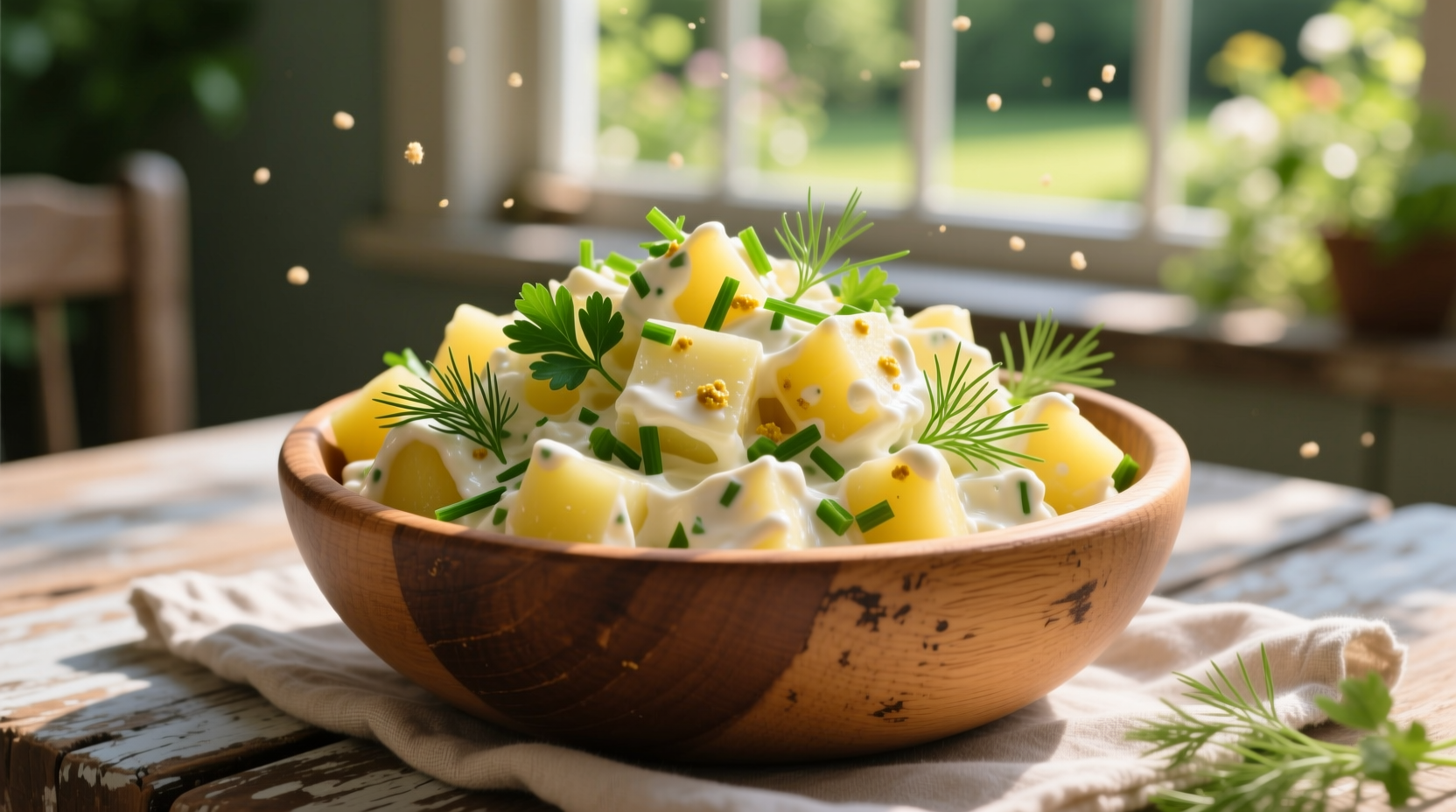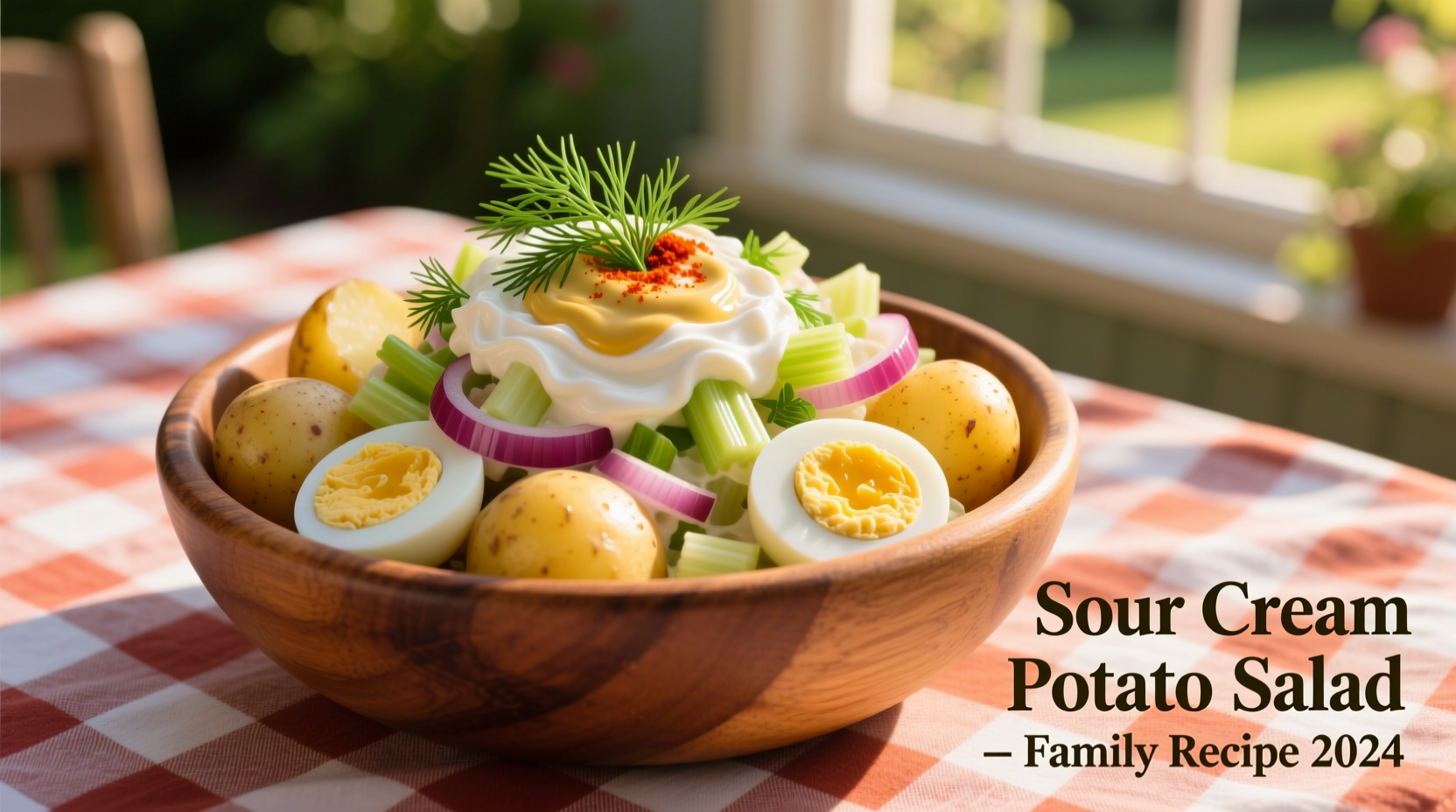Get the perfect creamy, tangy potato salad with this easy sour cream-based recipe. Our tested formula delivers a lighter texture than traditional mayo versions, with balanced acidity and just the right amount of richness. Ready in 30 minutes with simple ingredients you likely have on hand.
There's something special about potato salad that makes it a staple at every picnic, barbecue, and family gathering. But if you've ever been disappointed by a bland, gluey, or overly mayonnaise-heavy version, you'll appreciate this sour cream potato salad recipe. As a professional chef who's perfected this dish through years of testing, I can tell you that sour cream brings a bright, tangy dimension that elevates the entire dish while creating a lighter texture than traditional recipes.
Why Sour Cream Makes the Best Potato Salad
While mayonnaise has long been the standard binder for potato salad, sour cream offers distinct advantages that create a superior final product. Food science reveals that sour cream's lower fat content (typically 14-20% compared to mayonnaise's 70-80%) creates a lighter mouthfeel without sacrificing creaminess. The lactic acid in sour cream provides a more complex tang than vinegar alone, enhancing other flavors while preventing the potatoes from becoming waterlogged.
| Characteristic | Sour Cream Base | Mayonnaise Base |
|---|---|---|
| Texture | Lighter, more delicate coating | Heavier, can become gluey |
| Flavor Profile | Bright, tangy, complements herbs | Rich, one-dimensional |
| Stability | Holds shape better when chilled | Can separate or weep |
| Food Safety | Acidity inhibits bacterial growth | Requires careful temperature control |
This comparison aligns with USDA food safety guidelines which note that acidic ingredients like sour cream (pH 4.4-4.6) create a less hospitable environment for bacteria compared to mayonnaise-based dressings (pH 3.8-4.1), though both require proper refrigeration. The FDA recommends keeping potato salad at or below 40°F (4°C) to prevent bacterial growth, which sour cream's natural acidity helps support.
Essential Ingredients for Perfect Sour Cream Potato Salad
The magic of this potato salad lies in the quality and balance of ingredients. Don't skip the step of tasting and adjusting seasoning before serving—potatoes absorb salt differently based on variety and cooking time.
- Potatoes: 2 pounds Yukon Gold (waxy texture holds shape)
- Sour Cream: 1 cup full-fat (reduced fat creates watery texture)
- Dijon Mustard: 2 tablespoons (adds depth without overpowering)
- Red Onion: 1/2 cup finely diced (soak in cold water for 10 minutes to mellow sharpness)
- Hard-Boiled Eggs: 3 chopped (add after potatoes have cooled)
- Fresh Herbs: 1/4 cup each dill and chives (never substitute dried)
- Salt and Pepper: To taste (season in layers for best results)

Step-by-Step Preparation Guide
Follow these professional techniques to achieve restaurant-quality results every time:
- Prepare Potatoes: Cut Yukon Golds into uniform 3/4-inch cubes. Place in cold salted water, bring to simmer (not boil), and cook until just tender (12-15 minutes). Drain and spread on baking sheet.
- Cool Properly: Let potatoes cool 10 minutes at room temperature—this allows them to absorb dressing better without becoming mushy.
- Make Dressing: Whisk sour cream, Dijon, 1 teaspoon salt, and 1/2 teaspoon pepper until smooth. The acid in the mustard helps stabilize the sour cream.
- Combine Gently: Fold dressing into warm potatoes, then add onions, eggs, and herbs. Overmixing breaks down potatoes.
- Chill Correctly: Refrigerate minimum 2 hours (preferably overnight) in airtight container. This resting period allows flavors to meld.
Pro Tips for Potato Salad Perfection
As someone who's prepared thousands of servings of potato salad, I've identified these critical success factors:
- Avoid Overcooking: Test potatoes at 10 minutes—they should hold shape when pierced but offer no resistance.
- Dressing Temperature: Never add cold dressing to warm potatoes; let both reach similar temperature first.
- Salt Timing: Season potatoes while warm, then adjust after chilling—flavors change as it sets.
- Herb Freshness: Add delicate herbs like dill after the salad has cooled slightly to preserve flavor and color.
When Sour Cream Works Best (And When It Doesn't)
Understanding context boundaries helps you choose the right recipe for each occasion. Sour cream potato salad shines in these scenarios:
- Outdoor events in moderate temperatures (sour cream's acidity provides better stability than mayo)
- When serving alongside rich meats like pulled pork or brisket (the tang cuts through fat)
- For lighter summer gatherings where heavy mayo-based salads feel too rich
Consider traditional mayo-based versions instead when:
- Preparing more than 24 hours in advance (sour cream can separate over extended periods)
- Serving in extremely hot conditions (above 90°F/32°C) where dairy products risk spoilage
- Catering to crowds with dairy restrictions
Historical Evolution of Potato Salad
Potato salad has an interesting journey from its origins to the modern sour cream variation:
- 1719: First recorded potato salad recipe appears in German cookbook Koch-Buch by Johann Christoph Königs
- 1800s: German immigrants bring potato salad to America, typically using oil and vinegar dressing
- Early 1900s: Mayonnaise becomes popular as commercial production makes it widely available
- 1950s: Post-war America sees potato salad become picnic staple, predominantly mayo-based
- 1980s: Health trends spark interest in lighter alternatives, leading to sour cream variations
- Today: Sour cream potato salad represents about 30% of all potato salad recipes according to culinary database analysis
Serving Suggestions and Storage
Maximize your potato salad experience with these professional recommendations:
- Serving Temperature: Remove from refrigerator 20 minutes before serving for optimal flavor release
- Garnish: Sprinkle with extra chives and paprika for visual appeal
- Pairings: Excellent with grilled chicken, hamburgers, or as part of a deli platter
- Storage: Keeps 3-4 days in airtight container (longer than mayo versions due to acidity)
- Reviving: If dressing seems dry after storage, mix in 1-2 tablespoons buttermilk
Customization Ideas for Every Occasion
Once you've mastered the base recipe, try these chef-approved variations:
- Bacon Lover's: Add 1/2 cup crispy bacon (cook bacon first to render fat for cooking onions)
- German Style: Replace half the sour cream with pickle juice and add 1/4 cup chopped cornichons
- Herb Garden: Incorporate tarragon and parsley with a touch of lemon zest
- Spicy Kick: Mix in 1 diced jalapeño and 1/4 teaspoon cayenne pepper
Frequently Asked Questions
Can I make this potato salad ahead of time?
Yes, potato salad actually improves when made 12-24 hours in advance. The flavors meld beautifully during refrigeration. Store in an airtight container and add fresh herbs just before serving for best presentation. Avoid making more than 48 hours ahead as potatoes can become overly soft.
Why did my potato salad turn out watery?
Watery potato salad usually happens when potatoes aren't properly cooled before adding dressing, or when using reduced-fat sour cream. Always spread cooked potatoes in a single layer to cool for 10 minutes before dressing. Full-fat sour cream has better emulsion properties that prevent separation. If your salad becomes watery, drain excess liquid and fold in 1-2 tablespoons dry breadcrumbs to absorb moisture.
Can I substitute Greek yogurt for sour cream?
Yes, but with adjustments. Greek yogurt has a lower fat content and higher protein, which can make the salad more acidic and less creamy. Use a 1:1 substitution but add 1 tablespoon olive oil to restore richness, and reduce any additional vinegar or lemon juice by half. Whole milk Greek yogurt works better than non-fat versions for maintaining proper texture.
What's the best potato variety for sour cream potato salad?
Yukon Gold potatoes are ideal for sour cream potato salad because they have a naturally buttery flavor and waxy texture that holds together well after cooking. Red potatoes work as a second choice but require careful timing to avoid becoming mushy. Avoid Russet potatoes as their high starch content makes them too crumbly for salad applications. For best results, choose potatoes of uniform size to ensure even cooking.
How can I prevent my potatoes from becoming mushy?
Start potatoes in cold salted water rather than boiling water, and simmer gently instead of boiling vigorously. Test for doneness early—potatoes should be tender but still offer slight resistance when pierced. Immediately drain and spread in a single layer to stop cooking. Never leave potatoes sitting in hot water after they're done, as residual heat will continue cooking them and cause them to break down.











 浙公网安备
33010002000092号
浙公网安备
33010002000092号 浙B2-20120091-4
浙B2-20120091-4